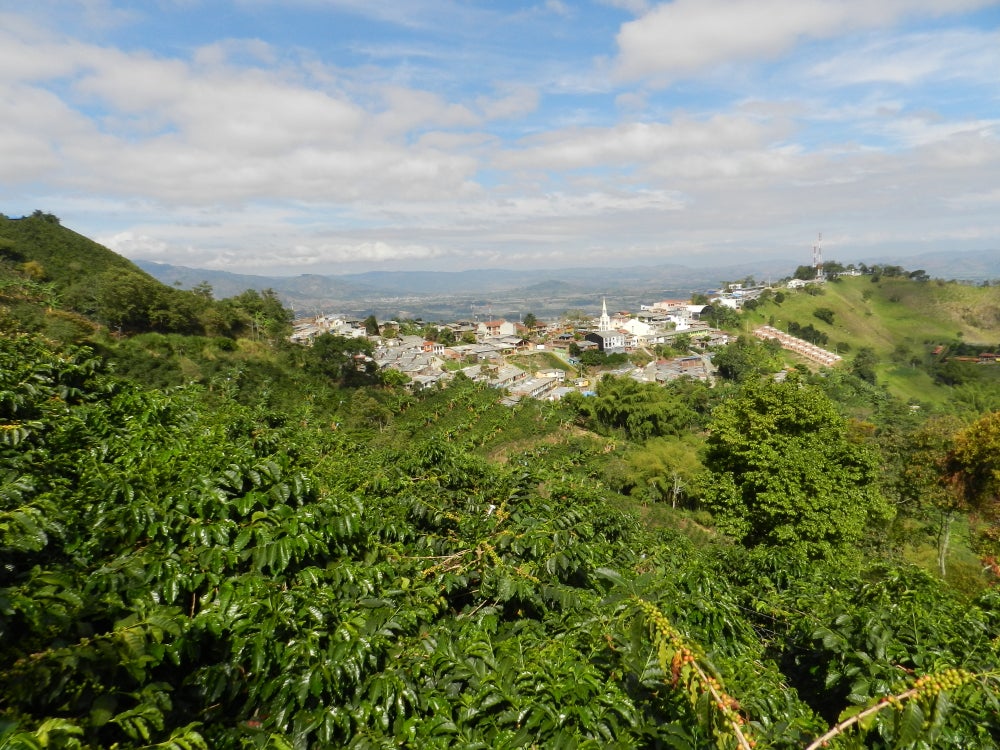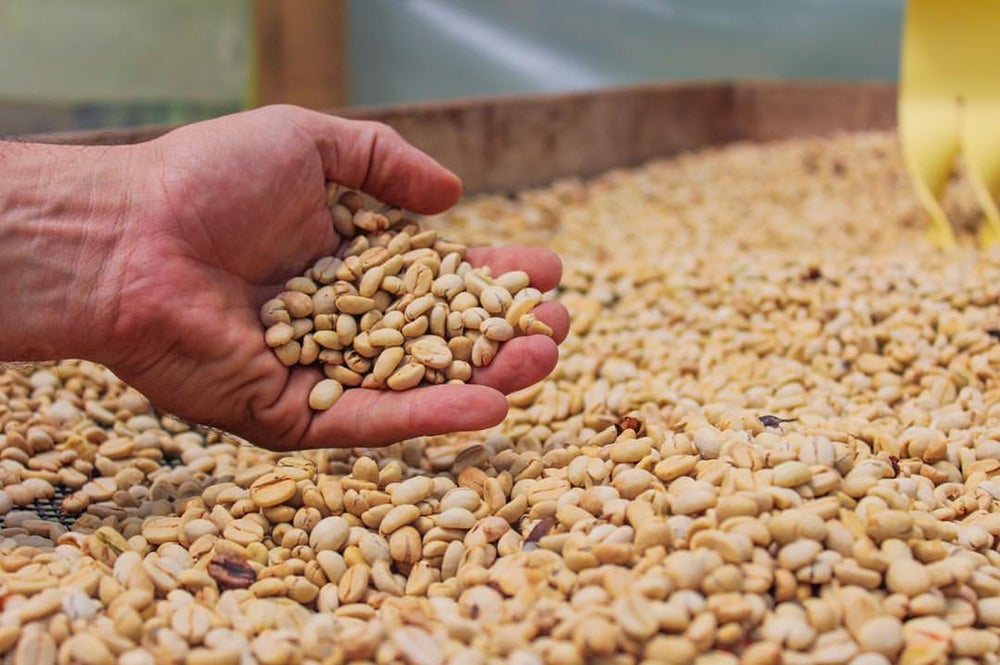

Colombia
Colombia has been producing and exporting coffees renowned for their full body and bright acidity since the early 19th century. Thanks to its wide range of coffee-growing regions, microclimates, and altitudes, Colombia can meet demand for coffee throughout the whole year.
Details
- Place In World Production:
- #3
- Average Annual Production:
- 13,800,000 (in 60kg bags)
- Common Arabica Varieties:
- Colombia, Castillo, Caturra, Typica, Bourbon
- Key Regions:
- Huila | Antioquia | Tolima | Cauca | Caldas | Risaralda | Quindío | Valle del Cauca | Santander | Nariño
- Harvest Months:
- Year-round, depending on the region
Offers
A History of Coffee
Although coffee production in Colombia did not become a large commercial industry until the 19th century, it is likely that coffee was introduced to Colombia about a century earlier by Jesuit priests.
Once commercial production started, it spread quickly. The first commercial coffee plantations were established in the northeast, near the border with Venezuela. Today, coffee is widespread and grown commercially in 20 of Colombia’s 32 Departments.
Historically, Colombia’s most renowned coffee-growing region has been the Eje Cafetero (Coffee Axis), also known as the ‘Coffee Triangle’. This region includes the departments of Caldas, Quindío and Risaralda. With a combined total area of 13,873 km² (5356 mi²), the region covers about 1.2% of the Colombian territory and composes 15% of the total land planted under coffee in the country. The region has also been declared a UNESCO World Heritage site.
While the Eje Cafetero is still a coffee-producing powerhouse, coffee production in Colombia now extends far beyond this zone. In recent years, the departments of Huila, Tolima, Cauca and Nariño have become sought after and well-known coffee-growing regions. Today, they are the largest producers of coffee in Colombia by volume.
Today, there are an estimated 540,000 coffee producers in the country; around 95% of these are smallholder farmers with landholdings that are under 5 hectares. These farmers collectively contribute around 16% of the country’s annual agricultural GDP.
A Multitude of Flavors
Colombia boasts a wide range of microclimates and geographic conditions that produce the unique flavors so loved in Colombian coffees. While there are many sub-regions and progressively smaller geographical designations — all the way down to individual farms — broadly speaking, coffees in Colombia can be separated into three major regions whose climate, soils and altitudes affect tastes.
Coffees grown in the north (Magdalena, Santander and Norte de Santander) are usually planted at lower altitudes where temperatures are higher. As such, these coffees tend to have deeper, earthier tastes with a medium acidity, more body and notes of nuts and chocolate.
Coffees coming from the central regions (Caldas, Quindío, Risaralda, North of Valle, Antioquia, Cundinamarca and North of Tolima) are celebrated for their overall balance and their fruity, herbal notes. Flavor variations highlight the specific characteristics of each micro-region.
The southern regions (Cauca, Nariño, Huila and South of Tolima) are prized for producing smooth coffees with high sweetness and citrus notes. They are also known for their medium body and more pronounced acidity.
Another distinguishing feature of Colombian coffee production is the mitaca crop – a second harvest that occurs roughly 6 months after the main crop in most regions. The mitaca crop is a result of moist ocean air rising from both the Pacific and the Caribbean, and the north-to-south orientation of the central cordilleras (mountain ranges).
Colombia’s wide range of climates also means that harvest times can vary significantly. Due to these varying harvest times — and the mitaca crop — fresh crop Colombian coffee is available nearly year-round.
Processing and Post-Harvest
Most farmers conduct primary processing (up to and including drying) on their own farms. Processing infrastructure varies widely but there are noticeable similarities between farms of similar sizes or regions. Broadly speaking, most farms have traditionally used the Fully washed method and utilized dry pulping to minimize water usage.
Drying processes in Colombia are innovative and varied. Farmers may spread their parchment across the flat roofs (elvas) of their houses to dry slowly – sometimes in the shade but more often in the sun.
In parts of Antioquia, drying ‘drawers’ are used. These are sets of moveable drying screens that can be pulled out from under the house or storage sheds when the weather is warm and pushed back under shelter when it rains.
Polytunnels and parabolic beds, also called marquesinas in Colombia, are also commonly used, particularly in high altitude and cooler temperatures zones. These structures are usually raised beds constructed similarly to mini-greenhouses with plastic sheeting stretched over an arched frame and openings at both ends to ensure airflow. These structures protect parchment from wet weather conditions while the even airflow allows for drying even in humid conditions.
As Colombian farmers are increasingly accessing specialty markets, they are experimenting with processing methods beyond the traditional Fully washed method. Producers are experimenting with all kinds of new methods and with adjustments to existing processing including changing fermentation times, adding yeasts or other products to fermenting coffee and more. They’re also producing more Naturals and Honeys of exceptional quality. And these processes are not limited to a select few. Along with Naturals and Honeys, experimentally processed coffees are now coming from a variety of regions.
Branding Colombian Coffee
Colombia’s coffee industry has been incredibly successful at building a brand that continues to help increase interest and demand for Colombian coffee. Beyond simply increasing demand, the industry’s branding made advertising history. Their iconic coffee farmer, Juan Valdez and his donkey, Conchita, were extremely recognizable.
Juan was initially created in 1958 for Colombia’s Federación Nacional de Cafeteros (FNC) (the Federation of Colombian Coffee Growers) and his visage graces the FNC logo – along with countless of bags of Colombian coffee – to this day.
The story of Juan Valdez is just one example of the ways FNC has been a strong force in creating continuity for the reputation of Colombian coffee. Since its creation in 1927, the FNC has represented the interests of Colombia’s coffee growers. Their continued presence is almost unique in the coffee world and is, in part, one of the reasons that Colombia is such a successful coffee-producing country.
Though originally a non-profit organization, today the FNC is collectively owned and controlled by approximately 540,000 producers across Colombia. In addition to cooking up genius marketing icons, the FNC works to ensure adequate infrastructure for growers, provides technical support and funds research. Their research division, Cenicafé (founded in 1938), is renowned for its focus on developing new genetic varieties and conducting research on improved farming practices.
The FNC also seeks price stabilization and ensures minimum pricing for Colombia’s coffee farmers. Despite this, labor shortages are a growing problem in the country, as young people move out of rural coffee-growing areas into the city. This situation is the ‘new normal’ for Colombian producers and the high cost of labor is one that is a risk for many and for the industry as a whole.
Certifications Expand Options
In addition to its wide variety of cup profiles, the popularity of certified coffee in Colombia has grown very quickly over the past decade. The most common certifications are Fairtrade, Rainforest Alliance (RFA), UTZ, and Organic. Company certifications such as Starbucks C.A.F.E. Practices are also becoming more widespread.
The increasing focus on the specialty industry is changing the way traders and farmers do business. It is becoming more common for farmers to reserve their highest quality beans in order to market them separately, at higher prices. Often, they can sell these lots with more traceability information that will reach all the way to the end customers. For farmers, having their name and life story connected to their coffee, which is then purchased and seen by the end user, brings many benefits. It means that they can nurture long-term relationships with roasters and increase the value of their product. For roasters, connecting farmers’ stories to the coffees they grew can create a stronger customer interest for specific coffees, added value and demand, and help finance successful long-term relationships with farmers.
Our Partners
Cafexport, our in-country partner, is built on the strength of 20 years of meaningful and productive relationships with Colombian coffee cooperatives.
Most of the coffees we purchase from Cafexport are the product of many years of partnership between Cafexport, cooperatives and farmers. Many are also certified, traceable coffees whose certification, combined with high quality processing and preparation, are sought after by established roasters across the globe.
The majority of the cooperatives with whom we work through Cafexport are from the regions of Caldas, Huila, Tolima, Antioquia, Quindío, Santander and Magdalena. We like to keep our list of sourcing regions long because diversification allows us to offer coffee with different specifications, flavors and harvest and shipping times to suit every need.
Sucafina in Colombia
Sucafina Colombia sources the full range of coffees from macrolot to microlot. We believe that the smartest way to source superb coffee is to build partnerships with quality-oriented producers and cooperatives.
Since 2017, Sucafina Colombia has built a vast network of partners throughout the country, working with actors throughout the supply chain, from independent producers to associations, cooperatives and exporters. With strong sourcing relationships as a focus, our sister company is strengthening coffee supply chains and meeting the needs of the growing coffee market.
Colombia’s coffee producers are increasingly quality-focused and innovative in the way they approach the growing specialty market. In 2019, Sucafina Colombia added a specialty branch to tap into this potential and to better source Colombia’s most distinct coffees. We support our supply partners as they experiment with everything from extended fermentation times to yeast inoculation to exotic varieties. Through our network of specialty-focused mills, we provide our clients with a wide range of qualities, including rare microlots, socially sustainable projects and our very own Sucafina Original blends: Huitaca and Bochica.
Sucafina Colombia operates a QC lab in Bogota, warehouses in Risaralda (Pereira), Tolima (Ibagué) and Huila (Pitalito and Neiva) and a dry mill in Neiva. We partner with a diverse selection of quality-driven suppliers ranging from cooperatives and associations to parchment traders and independent producers. This structure ensures our supply and enables us to source everything from macrolot to microlot.
Our dry mill is strategically located at the heart of the Huila department, the epicenter of Colombian coffee production. Parchment arrives from across Huila and from other producing regions, including Eje Cafetero, Cauca and Tolima.
At our mill, we receive coffee from producers across Colombia. Our dedication to clear communication and timely payments draws suppliers to us, allowing us to select the crème-de-la-crème from the large quantities of coffee available to us.
Our in-house laboratory and highly qualified technical and professional staff process up to 1,300 bags daily. The mill is RFA/UTZ, Fairtrade, Organic and Café Practices certified